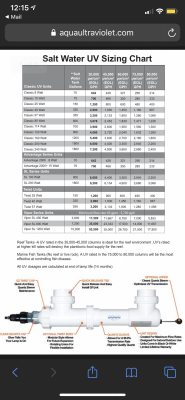OK...SO WHICH UV IS THE PICK OF THE LITTER?
HOW DO I SIZE ONE? MY Red Sea MAX S 5OO IS MIXED REEF - 135 GAL WITH SUMP.
THANKS.
I've built, repaired, and modified them from numerous brands. My buddy's even cut up aquaUV's, extended them, redone the ballasts, etc.
Having said this, I much prefer AquaUV over all the others. The seal design is the best, the clear cap has some kind of UV-reactive dye injected into it, you can tell they've been doing this a while....
TMC is probably best bang for the buck, the only issue is they use dual-sided T8s, meaning there's two seals, on each end. More points for leaking. However, for the money, good value.
Emperor/Pentair comes in third, i just don't like the seal designs on them. They put the one seal INSIDE the unit, like you sort of assemble the quartz tube then slide the thing in....where as aquaUV's and TMC it's all accessible from the end. I just don't like this design. I also have seen more failed ballasts with them, in the past, but they're all mostly sticking workhorse's inside of plastic tube. I had a emperor 40w that came with a workhorse 22 ballast, at most, it was under-driving it at 36w...I wasn't impressed. That doesn't fly with me...they are mostly using different ballast now with pentair taking them over, but all and all, they're my 3rd choice.
ignore all the china stuff, most isn't even made out of proper UVC resistant PVC, it needs to be furniture grade or UV grade PVC.....
For that size tank, I'd use a 40w or 57w.


















